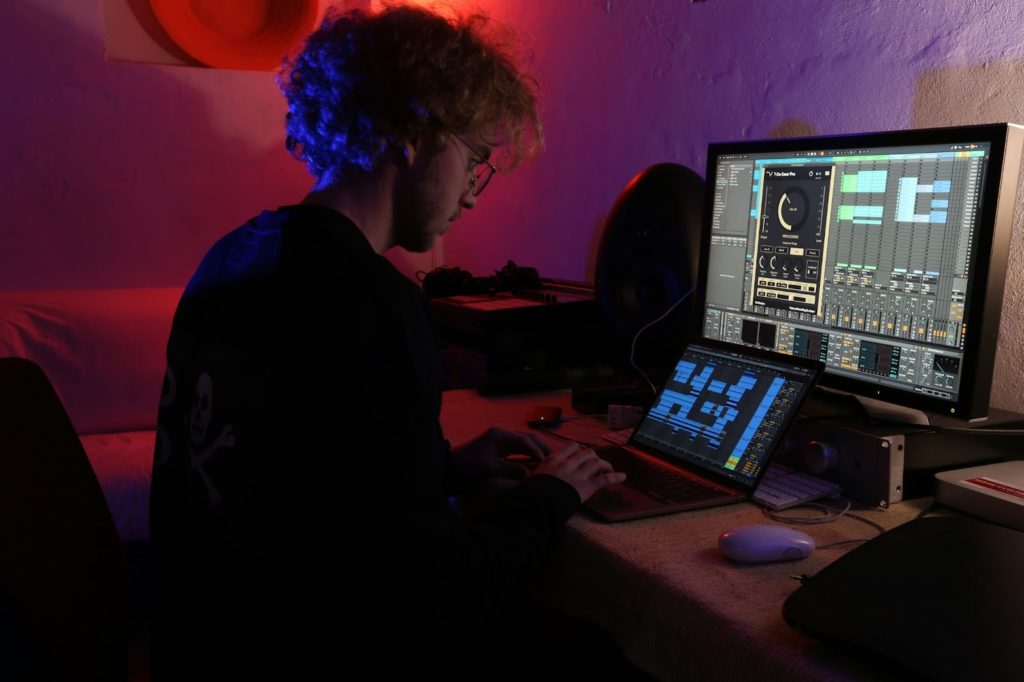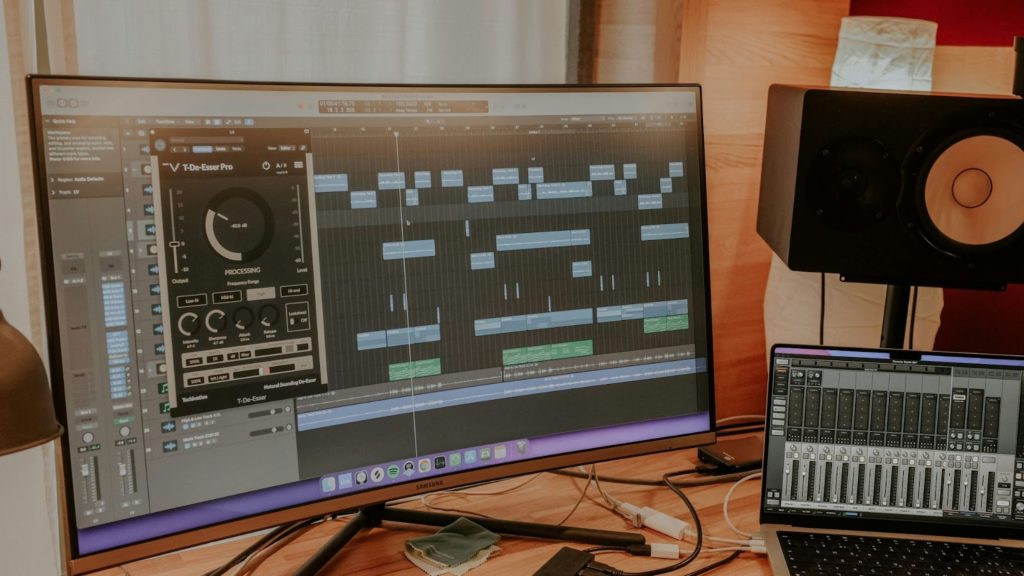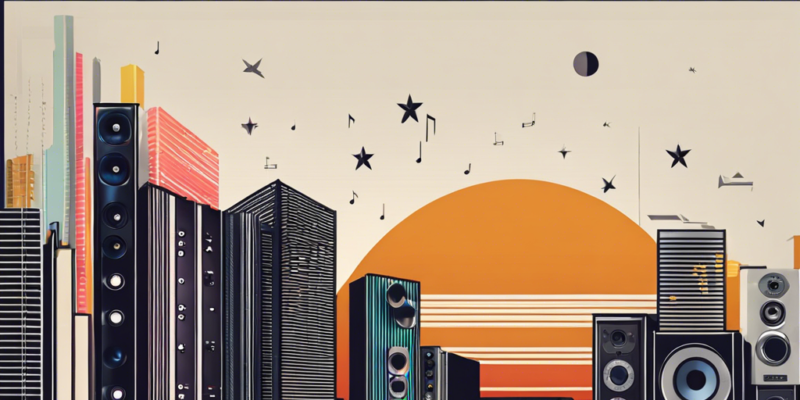You’re witnessing a shift in the music landscape as global collaborations are drastically shaping modern music. Artists from every corner of the world are now working together, blending unique sounds and styles, creating music that is delightfully innovative. This exchange of cultural influences is not only revolutionizing the industry but also bridging cultural gaps. But what does this mean for the future of music? And how does this impact the listener’s experience? Let’s explore this intriguing transformation further.
The Power of Global Collaboration
In this interconnected world, the power of global collaboration in music has become a transformative force, fostering a rich cultural exchange and broadening the creative horizons of artists worldwide. You’ve probably noticed an explosion of musical diversity, a direct result of this global connectivity. It’s not just about blending genres anymore, but also infusing different cultural nuances, creating a unique auditory tapestry that immerses you in a world of sound.
This creative synergy between artists from diverse backgrounds leads to innovative compositions. It’s not about sticking to what’s safe or familiar anymore. You’re hearing new sounds, new rhythms, new harmonies that challenge the status quo.
Through this cultural exchange, artists are pushing the boundaries of what’s considered ‘traditional’ music. It’s about embracing the unfamiliar and transforming it into something extraordinary. This artistic innovation is only possible due to the power of global collaboration.
You’re living in an era where a musician in New York can collaborate with a composer in Tokyo without ever leaving their respective cities. This is the new age of music, fuelled by global connectivity and characterized by diversity, innovation, and synergy. It’s a fascinating time, don’t you think?
Music: A Universal Language

Bridging cultural divides, music serves as a universal language that’s not bound by geography or ethnicity, don’t you agree? This creative synergy fosters an environment of cultural exchange, allowing artists worldwide to blend their unique sounds into harmonious diversity. You’ll find that global connections have led to a surge in musical fusion, transforming the sonic landscape and challenging traditional ideas about genre boundaries.
Think about it. Can you imagine a world where K-Pop blends with Latin rhythms or where Celtic melodies merge seamlessly with African beats? This isn’t just a fanciful thought; it’s happening, and it’s exhilarating. The cross-cultural collaborations we see today aren’t just about creating new music; they’re about understanding and celebrating our shared humanity.
Music is more than notes and rhythms; it’s a powerful tool for unity. It fosters dialogue, encouraging us to listen, learn, and appreciate the array of sounds that make our world so vibrant. It’s a confirmation of our shared human experience, proof that, despite our differences, there’s a universal rhythm that binds us together. So, don’t you think it’s time we celebrated this harmonious diversity nurtured by global musical fusion?
Impact of Digital Platforms

Now, let’s consider how digital platforms have further amplified this global musical fusion, transforming the way artists collaborate and creating a richer, more diverse music scene. Digital innovation has been a game-changer. It’s not just about streaming and downloading anymore; it’s about creating, sharing, and collaborating in real-time, across continents, and with an ease that was unimaginable a few decades ago.
Virtual connectivity has made artistic exchange more fluid, breaking down geographical and cultural barriers that once limited creative interaction. Whether it’s a beatmaker in Berlin working with a singer in Seoul or a producer in New York remixing a track from Nairobi, the global influence is palpable and exciting.
This online creativity has led to an explosion of unique sounds and styles, reflective of our increasingly interconnected world. You’re no longer just influenced by your immediate surroundings, but by a plethora of sounds and styles from across the globe. In essence, digital platforms have democratized music, making it more inclusive, diverse, and vibrant than ever before. It’s clear that the digital age isn’t just shaping the music we listen to; it’s reshaping the way it’s being created.
Cross-Cultural Musical Fusion
Drawing from this global pool of diverse sounds, cross-cultural musical fusion is taking center stage, challenging traditional boundaries and sparking fresh, innovative melodies. This emergence of fusion music, an intriguing blend of different genres, can be largely attributed to cultural exchange and global influences. It’s a tribute to the power of music as a universal language, capable of transcending borders and uniting people.
You might wonder how such fusion is achieved? It’s a creative process of musical exploration, where musicians experiment with diverse sounds, drawing inspiration from a variety of cultures. Through collaborations, they create harmonious blends, producing unique, genre-defying music.
Yet, it’s not just about blending sounds. Cross-cultural musical fusion also involves understanding and respecting the origins of these diverse sounds. It’s about recognizing the shared human experience behind each melody, rhythm, and lyric. This fusion is a celebration of our global connectedness and shared love for music.
In essence, cross-cultural musical fusion is more than just a trend; it’s a reflection of our interconnected world. It encapsulates the spirit of cultural exchange, the thrill of musical exploration, and the limitless possibilities that come with global influences. It’s a journey through the world’s soundscape, one melody at a time.
Influence of World Music Genres
Exploring the vast ocean of world music genres, you’ll quickly realize their profound influence on the modern music scene. This influence stems from a cultural exchange that encourages global creativity, and is reshaping the way we perceive and create music.
This musical fusion is more than just genre blending; it’s a dialogue between cultures, an exchange of traditional influences that’s driving the evolution of music. For instance, you’ll find the vibrant rhythms of African drumming in modern hip-hop, or the melancholic melodies of Asian instruments in contemporary pop.
Moreover, you’ll notice how artists are increasingly incorporating elements from diverse cultures into their work, creating a soundscape that’s not confined to geographical boundaries. It’s a reflection of the power of music as a universal language, where shared melodies and rhythms bridge cultural gaps.
Undeniably, the influence of world music genres extends beyond just sound. It’s shaping the way artists compose, perform, and perceive music, fostering a global creativity that’s both transformative and inclusive. As you explore further, you’ll appreciate how this musical fusion isn’t just an artistic trend, but a powerful tool for cultural understanding and unity.
The Role of Music Festivals
As you immerse yourself in the world of music, you’ll find that music festivals play a significant role in this global exchange of cultural influences and musical ideas. Festivals aren’t just about live performances; they’re platforms for festival collaborations, creating a cultural exchange that shapes music globally.
- Festival Collaborations: Music festivals offer opportunities for artists from different backgrounds to collaborate, leading to unique music that wouldn’t exist otherwise.
- Global Stages: Festivals provide a global stage where artists showcase their creativity to international audiences. This exposure often leads to further creative partnerships.
- Cultural Exchange: Music festivals are melting pots of cultural diversity, facilitating a rich exchange of musical ideas and influences.
- Creative partnerships: Music festivals foster an environment of creative partnerships, where artists can experiment and innovate, pushing the boundaries of their musical genres.
Case Studies: Successful Collaborations
Let’s explore some successful collaborations that have greatly shaped the modern music scene and examine how these partnerships were formed.
One striking example is the rise of virtual jamming. Bands like Radiohead and Gorillaz have mastered this art, jamming together while physically apart, breaking geographical boundaries, and creating enthralling music. Similarly, remote recording has allowed artists like Taylor Swift to produce albums during lockdowns. Swift’s ‘Folklore’ and ‘Evermore’ are demonstrations of the power of remote collaborations, bringing together musicians and producers from different locations.
International duets have also flourished in this digital age. Take Luis Fonsi and Daddy Yankee’s ‘Despacito’ remix featuring Justin Bieber, a cross-cultural collaboration that dominated global charts. Similarly, the digital duo BTS and Halsey’s ‘Boy With Luv’ broke records, amassing millions of views within hours of its release.
Online partnerships aren’t just limited to artists. Platforms like Soundtrap and BandLab have allowed musicians to collaborate on compositions, fostering a new level of global musical camaraderie. These cases underline the extent to which global collaboration has revolutionized the music industry, turning it into a borderless creative playground.
Collaborative Music Production Techniques
In the world of music production, understanding the techniques behind successful online collaborations can give you a unique edge in this rapidly evolving industry. Digital collaboration is no longer a novelty but an essential, and mastering its techniques is important.
Here are four key techniques to keep in mind:
- Virtual Jamming: This involves real-time interaction with musicians from around the globe. It’s like a physical jam session, only it’s done online. This technique can spark creative ideas and foster a sense of community among artists.
- Remote Recording: This lets you record your parts separately, then share them online for others to add their touch. It offers flexibility and convenience without compromising on quality.
- Online Mixing: This enables you to combine different tracks and fine-tune the overall sound, regardless of where the original recordings were made.
- Global Networking: This is about building relationships with other musicians, producers, and industry professionals worldwide. It provides opportunities for collaboration, mentorship, and exposure.
Barriers in Global Collaboration
While global collaboration in music has numerous benefits, it’s not without its barriers and challenges that can hinder the process. Language barriers, for instance, can create misunderstandings which may lead to creative conflicts. You might find it difficult to convey your ideas or comprehend your collaborator’s vision, leading to a discordant output.
Time zones can pose another hurdle. When you’re working with someone halfway across the globe, synchronizing schedules can become a logistical nightmare. This can delay the creative process and put undue pressure on both parties involved.
Cultural differences, too, can be a mixed bag. While they can lead to unique, innovative mixes, they can also cause friction if not navigated with sensitivity and respect. It’s important to understand and respect your collaborator’s background and musical tradition.
Technological limitations can’t be overlooked either. Not everyone has access to high-speed internet or advanced musical equipment. This can impact the quality of the collaboration and might even discourage some musicians from participating in global projects.
In spite of these challenges, many musicians persevere, and the results are often worth the effort. But it’s clear that for global collaboration to truly thrive, these barriers need to be addressed.
The Future of Musical Collaborations
Peering into the future of musical collaborations, it’s exciting to contemplate how emerging technologies and platforms might further revolutionize this space. The possibility of immersive virtual ensembles and innovative techniques like AI-driven compositions is tantalizing. Here’s a glimpse into the future:
- Global partnerships: Expect to see more collaborations between artists from different cultures and backgrounds. This cultural exchange will infuse the music industry with fresh sounds and narratives.
- Innovative techniques: With advancements in technology, artists will experiment with new ways of creating and sharing music. This will push the boundaries of what’s considered ‘music’.
- Virtual ensembles: Thanks to technology, geographical barriers will continue to diminish. Musicians will be able to collaborate in real-time from different corners of the world, creating virtual ensembles.
- Collaborative creativity: Music creation will become a more collective process, with fans and artists co-creating songs.
The future of musical collaboration is bright and filled with opportunities. As global partnerships and cultural exchange become the norm, music will continue to evolve, reflecting the diverse world we live in. This is the future of music – a future fuelled by collaborative creativity.
Economic Impact on the Music Industry
The music industry’s economic landscape has dramatically shifted with the advent of online collaboration platforms, hasn’t it? These platforms have redefined industry growth, opening up new financial benefits and market opportunities that were previously inaccessible.
Traditional barriers have been broken down, enabling artists from all corners of the globe to connect, share, and monetize their talents. This has led to the creation of diverse revenue streams, from subscription fees, digital downloads, to ad revenues. It has also facilitated an increase in the volume of music produced, contributing to the industry’s economic sustainability.
Moreover, online collaborations have democratized the music industry. Even independent artists, who don’t have the financial backing of large record companies, can now access global audiences and reap financial rewards. The availability of these platforms has leveled the playing field, making it possible for anyone with talent to participate in the music industry’s economic growth.
In this digital age, the music industry is no longer just about big record labels and superstar artists. It’s about global collaboration, technology, and innovation, isn’t it? This shift has certainly contributed to the industry’s economic resilience and continuous growth.
Social Effects of Music Collaboration
Have you ever considered how music collaboration platforms are reshaping the social landscape of the music industry? These platforms are more than just creative spaces; they’re catalysts for cultural exchange, community building, creative partnerships, artistic growth, and global connectivity.
Consider these four significant impacts:
- Cultural Exchange: Music collaboration platforms break down geographical barriers, allowing artists from diverse cultures to share their unique sounds and styles. This fosters a rich exchange of ideas that fuels innovation in music.
- Community Building: These platforms create online communities where artists can support, inspire, and learn from each other. This sense of community can be empowering, especially for independent artists.
- Creative Partnerships: Artists can discover like-minded peers on these platforms, leading to collaborations that mightn’t have been possible otherwise. These partnerships can stimulate artistic growth and create music that transcends genre boundaries.
- Global Connectivity: Music is a universal language, and these platforms are making it easier than ever for artists around the world to connect, create, and share their work with a global audience.
This new era of social connectivity in music is transformative, creating a world where music is more diverse, inclusive, and vibrant than ever before.
How Collaboration Shapes Music Trends
While you mightn’t realize it, music collaboration platforms like BeatConnect are actively shaping trends in the modern music scene. These online creative spaces are the birthplaces of trend-setting collaborations that push the boundaries of what’s deemed musically possible
These platforms provide a space for artists to blend genres and experiment with various musical influences. They enable collaborations, regardless of geographical boundaries, nurturing a truly global musical culture. You’ll hear a Scandinavian folk singer blending rhythms with an African drummer, or a K-pop band integrating Latin beats into their songs. This collaborative creativity is the heartbeat of these platforms.
Such genre-blending partnerships aren’t just novelty acts but are setting lasting trends. They’re reshaping the music industry, making it more inclusive and diverse. Through this musical innovation, new sub-genres are born, and unexplored musical territories are charted.
These platforms are more than just a tool for collaboration. They’re catalysts for change, driving the evolution of music trends. They’re breaking down barriers, fostering creativity, and helping create a unified global music community. So next time you’re listening to that hot new track, remember, it’s likely a product of collaborative creativity on a global scale.
Conclusion
Global collaboration is revolutionizing music, breaking barriers, creating a musical ‘melting pot’, and driving social change. This transformation isn’t just a passing trend; it represents the future of music. The result is a rich, vibrant, and diverse musical landscape that is more exciting than ever. Embrace this change, ride the wave, and witness how unity and harmony are reshaping the music we know and love.
Let’s come together to experience the power of collaboration in music and appreciate how it is shaping a new musical era.
Photo Sources:
https://i.postimg.cc/BvvJKgwN/Creating-Harmony-How-Global-Collaboration-Is-Shaping-Modern-Music.png
https://unsplash.com/photos/a-man-sitting-in-front-of-a-computer-monitor-vVRmYWSWy7A
https://unsplash.com/photos/a-laptop-computer-sitting-on-top-of-a-wooden-desk-a950smHhDeQ

